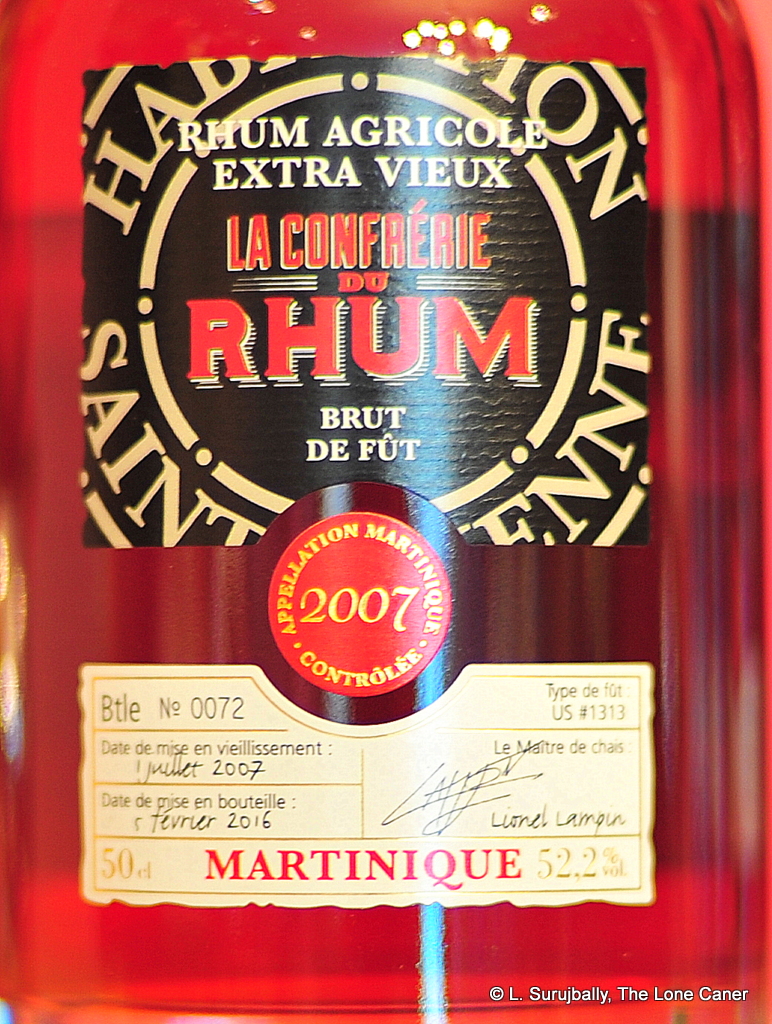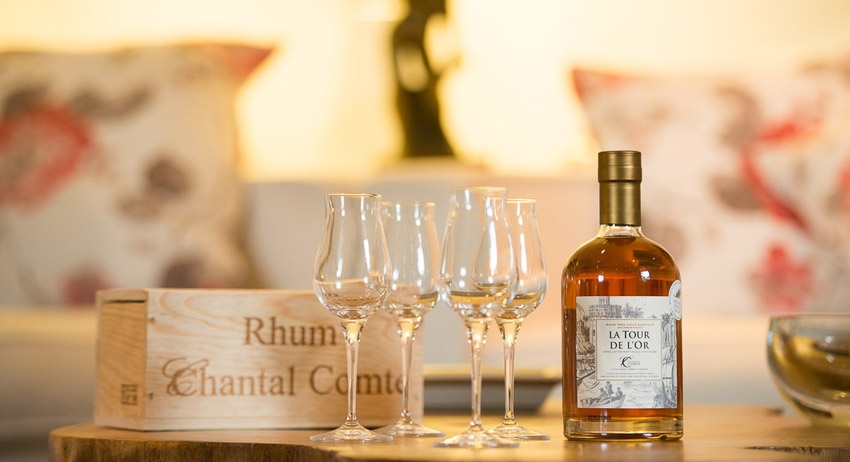HSE – or Habitation Saint Etienne – is a small distillery on Martinique whose products I dally with on and off like a lovelorn swain who can’t make up his mind. They have all the usual products attendant upon Martinique’s distilling scene: unaged blancs, aged agricoles of various years with a finish or special barrrel ageing thrown in here or there, the occasional millesime, indie bottlers’ outputs and even a parcellaire or two for those who like to take apart miniscule deviations in a single distillery’s profile. All of the rhums from the distillery which I’ve tried have been very good, at any age and any strength, so it’s a wonder we don’t seek them out more assiduously.
They are the real deal, and produce a full suite of AOC rhums, yet I sometimes get the impression that they lag somewhat in people’s awareness or estimation behind other French island outfits such as, oh, J.M., Saint James, Damoiseau, Labatt or Clement (disregard this comment if you are already and always have been an HSE fan). Not that this matters much because like with any quality product, those who know, know. And clearly they know why.
The stats, then: the rhum is blend of unaged whites made on Martinique from cane juice on a column still, distinguished by being reduced after distillation down to 50° over a period of (get this!) six months. It is named after Titouan Lamazou, a French navigator, sailor, artist and writer who was famous for his sailing exploits (he won the arduous round the world Vendée Globe race in 1990 and gained the title of world racing champion in 1991). Also an accomplished artist, in 2015 he staged an exhibition of his portraits of women created over a number of years for his “Women of the World” project in collaboration with Habitation Saint Etienne, and since the first references to the rhum come right around this time, it’s reasonable to suppose the first edition came out in that year, or in 2016. It continues to be made as a limited release, which makes it a millesime rhum (this one is from 2021), and the label design is supposedly his own.
 All that is fine, yet we’ve been burned by sweet smiles and pretty dresses before: sometimes the adornment is the best thing about it. I come before you to say, fear not, for this rhum is great. When nosing it at the Berlin Rumfests’s pre-festival group tasting (I had sneaked in and was invited to hang out with the cool kids) it started with an elegance I was not expecting, with a sweetly rounded aroma combining perfumed flowers and salt with lovely deep notes of sugar cane syrup. Keeping it on the go for an hour, it developed more muscular smells of dark red olives, hot olive oil just at the smoke point, sugar water, cucumbers, sprite and watermelons, all overlain by that light and almost delicate floral, even herbal aroma that made me think of sun-dappled flower-strewn clearings in green forests, steaming after a warm rain.
All that is fine, yet we’ve been burned by sweet smiles and pretty dresses before: sometimes the adornment is the best thing about it. I come before you to say, fear not, for this rhum is great. When nosing it at the Berlin Rumfests’s pre-festival group tasting (I had sneaked in and was invited to hang out with the cool kids) it started with an elegance I was not expecting, with a sweetly rounded aroma combining perfumed flowers and salt with lovely deep notes of sugar cane syrup. Keeping it on the go for an hour, it developed more muscular smells of dark red olives, hot olive oil just at the smoke point, sugar water, cucumbers, sprite and watermelons, all overlain by that light and almost delicate floral, even herbal aroma that made me think of sun-dappled flower-strewn clearings in green forests, steaming after a warm rain.
The depth and intensity of the palate was really quite superlative as well, and demonstrated no fall off from the way it smelled. It presented with a smooth texture, tasting of solvent, bubble gum and and melded the crisp tart sweetness of unsweetened yoghurt with lemon meringue pie, green grapes and apples. There is a clean snap of citrus and coffee grounds, a touch of sweet soya and a nice sort of understated sourness to it all, leading to a long and languorous finish redolent of lemon peel, pastries, laban and a very sweet and mild balsamic vinegar.
All this from a white unaged rum. It’s really quite amazing and a standout at every level, even while you’d strain to find a single point of excellence about it. It raises the bar all at once so the singularity I search for is tough to describe, except to say – it’s really good and can function well as a sipper, while not losing its ability to turbocharge a mix in fine style.
That a rhum with such a top notch profile doesn’t ring more bells or launch small cults, that it sells at an insanely low price of around or less than €40 is, on the face of it, incredibly fortunate for us rum proles, because for once we can actually get us a good one and not sell a kidney to do so. Sure it’s a branded product commemorating a sports figure, sure it’s a blend whose stats seem to make it just another blanc, and sure it’s unaged and taken at agricole’s standard strength – nothing besides the beautiful label design really marks it out. But I maintain that through some subtle alchemy known only to the makers, HSE created a quietly, sweetly, unprepossessing little masterpiece that lit up my eyes and brought a grin to my face from the moment I nosed it. It was the first really top rum I sampled at the beginning of my 2023 rum festival experience – and was still one of the best at the end.
(#1011)(91/100) ⭐⭐⭐⭐½
Other Notes
- The bottle notes it is a limited edition without elaboration, so for now I can’t tell you how many bottles are out there. Apparently there’s a 40% version out there as well.
- Brief distillery background: Habitation Saint-Étienne is located almost dead centre in the middle of Martinique. Although in existence since the early 1800s, its modern history properly began when it was purchased in 1882 by Amédée Aubéry, who combined the sugar factory with a small distillery, and set up a rail line to transport cane more efficiently (even though oxen and people that pulled the railcars, not locomotives). In 1909, the property came into the possession of the Simonnet family who kept it until its decline at the end of the 1980s. The estate was then taken over in 1994 by Yves and José Hayot — owners, it will be recalled, of the Simon distillery, as well as Clement — who relaunched the Saint-Étienne brand using the original stills from HSE but relocating them to Simon (ageing remained at the Habitation), adding snazzy marketing and expanding markets.
- Of course I’m not the first to mention the rhum. My good friend Laurent Cuvier (he of the now-retired poussette) mentioned it enthusiastically way back in 2019 on a distillery visit when he got a try way before it was released, and again in his 2023 Paris Rhumfest roundup. Serge, ever ahead of the curve, tried an earlier edition back in 2016 – it may even have been the first – and liked it to the tune of 86 points which for him, back then, was well nigh unheard of.


 Given that it is nine years tropical ageing plus another year in the Sauternes casks, I think we could be expected to have a pretty interesting profile — and I wasn’t disappointed (though the low 41% strength did give me pause). The initial smells were grassy and wine-y at the same time, a combination of musk and crisp light aromas that melded well. There were green apples, grapes, the tart acidity of cider mixed in with some ginger and cinnamon, a dollop of brine and a few olives, freshly mown wet grass and well-controlled citrus peel behind it all.
Given that it is nine years tropical ageing plus another year in the Sauternes casks, I think we could be expected to have a pretty interesting profile — and I wasn’t disappointed (though the low 41% strength did give me pause). The initial smells were grassy and wine-y at the same time, a combination of musk and crisp light aromas that melded well. There were green apples, grapes, the tart acidity of cider mixed in with some ginger and cinnamon, a dollop of brine and a few olives, freshly mown wet grass and well-controlled citrus peel behind it all. 







